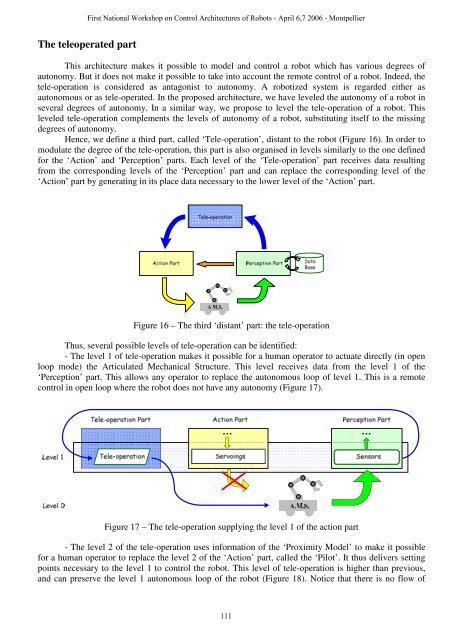Pleading for open modular architectures - Lirmm
Pleading for open modular architectures - Lirmm
Pleading for open modular architectures - Lirmm
You also want an ePaper? Increase the reach of your titles
YUMPU automatically turns print PDFs into web optimized ePapers that Google loves.
The teleoperated part<br />
First National Workshop on Control Architectures of Robots - April 6,7 2006 - Montpellier<br />
This architecture makes it possible to model and control a robot which has various degrees of<br />
autonomy. But it does not make it possible to take into account the remote control of a robot. Indeed, the<br />
tele-operation is considered as antagonist to autonomy. A robotized system is regarded either as<br />
autonomous or as tele-operated. In the proposed architecture, we have leveled the autonomy of a robot in<br />
several degrees of autonomy. In a similar way, we propose to level the tele-operation of a robot. This<br />
leveled tele-operation complements the levels of autonomy of a robot, substituting itself to the missing<br />
degrees of autonomy.<br />
Hence, we define a third part, called ‘Tele-operation’, distant to the robot (Figure 16). In order to<br />
modulate the degree of the tele-operation, this part is also organised in levels similarly to the one defined<br />
<strong>for</strong> the ‘Action’ and ‘Perception’ parts. Each level of the ‘Tele-operation’ part receives data resulting<br />
from the corresponding levels of the ‘Perception’ part and can replace the corresponding level of the<br />
‘Action’ part by generating in its place data necessary to the lower level of the ‘Action’ part.<br />
Figure 16 – The third ‘distant’ part: the tele-operation<br />
Thus, several possible levels of tele-operation can be identified:<br />
- The level 1 of tele-operation makes it possible <strong>for</strong> a human operator to actuate directly (in <strong>open</strong><br />
loop mode) the Articulated Mechanical Structure. This level receives data from the level 1 of the<br />
‘Perception’ part. This allows any operator to replace the autonomous loop of level 1. This is a remote<br />
control in <strong>open</strong> loop where the robot does not have any autonomy (Figure 17).<br />
Figure 17 – The tele-operation supplying the level 1 of the action part<br />
- The level 2 of the tele-operation uses in<strong>for</strong>mation of the ‘Proximity Model’ to make it possible<br />
<strong>for</strong> a human operator to replace the level 2 of the ‘Action’ part, called the ‘Pilot’. It thus delivers setting<br />
points necessary to the level 1 to control the robot. This level of tele-operation is higher than previous,<br />
and can preserve the level 1 autonomous loop of the robot (Figure 18). Notice that there is no flow of<br />
111

















